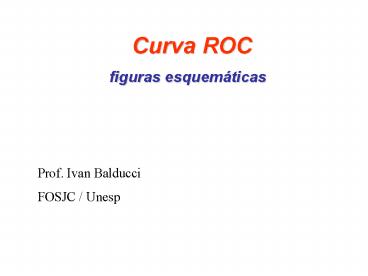Curva ROC figuras esquem - PowerPoint PPT Presentation
1 / 24
Title:
Curva ROC figuras esquem
Description:
Curva ROC figuras esquem ticas Prof. Ivan Balducci FOSJC / Unesp Lab Tests: What is Abnormal ? The Cut-off Value Trade off Sensitivity and specificity depend on ... – PowerPoint PPT presentation
Number of Views:113
Avg rating:3.0/5.0
Title: Curva ROC figuras esquem
1
Curva ROCfiguras esquemáticas
Prof. Ivan Balducci FOSJC / Unesp
2
Receiver Operating Characteristic (ROC) Curve
Each threshold c corresponds to a point (FPR, DR)
on the X-Y plane. A ROC curve is obtained as c
sweeps from - ? to ?.
2
3
Lab Tests What is Abnormal?
4
Desempenho
True Positive
True Negative
A
B
False Negative
False Positive
TP Classe é A e classificamos como A TN
Classe é B e classificamos como B FP Classe é B
e classificamos como A FN Classe é A e
classificamos como B
5
The Cut-off Value Trade off
- Sensitivity and specificity depend on the cut off
value between what we define as normal and
abnormal - Assume high test values are abnormal then,
moving the cut-off value to a higher one
increases FN results and decreases FP results
(i.e. more specific) and vice versa - There is always a trade off in setting the
cut-off point
6
Receiver Operating Characteristic (ROC) Curve
Each threshold c corresponds to a point (FPR, DR)
on the X-Y plane. A ROC curve is obtained as c
sweeps from - ? to ?.
6
7
ROC Curve
8
Receiver Operating Characteristic (ROC) Curves
9
Goodness-Of-Fit Other Measures of Model
Performance
- ROC (Receiver Operating Characteristic) Curve
- Sensitivity and Specificity are dependent on a
given cut-point c. - An ROC curve is obtained by plotting sensitivity
against (1-specificity) for an entire range of
possible cut-points. - The area under the ROC curve is a measure of the
models ability to discriminate between event and
non-event in the following fashion - Among all possible pairs (event, non-event), the
proportion of pairs for which the event has
higher probability than the corresponding
non-event is equal to the area under ROC.
10
ROC Curve
- Interpretation Area Under ROC Curve
- If randomly selected pairs of subjects (one with
event and one with non-event) are classified in
such a way that the subject with higher estimated
probability of the event belongs to the event
group and the other subject to non-event group,
then the proportion of correctly classified such
pairs of subjects would be equal to the area
under ROC - Generally Accepted Rule
- ROC 0.5 no discrimination (no
better than coin toss) - 0.7 lt ROC lt 0.8 acceptable discrimination
- 0.8 lt ROC lt 0.9 excellent discrimination
- ROC gt 0.9 outstanding
discrimination - Roc area is often used to compare predictive
ability of different models
11
The ROC
- The ROC shows the tradeoff between PFP and PTP
as the threshold is varied
12
(No Transcript)
13
(No Transcript)
14
Developmental characteristics Cut-points and
Receiver Operating Characteristic (ROC)
Healthy
15
Developmental characteristics Cut-points and
Receiver Operating Characteristic (ROC)
Healthy Sick
16
Developmental characteristics Cut-points and
Receiver Operating Characteristic (ROC)
Fals pos 20 True pos82
17
Developmental characteristics Cut-points and
Receiver Operating Characteristic (ROC)
Fals pos 9 True pos70
18
Developmental characteristics Cut-points and
Receiver Operating Characteristic (ROC)
Healthy
19
Developmental characteristics Cut-points and
Receiver Operating Characteristic (ROC)
Healthy Sick
20
Developmental characteristics Cut-points and
Receiver Operating Characteristic (ROC)
Fals pos 20 True pos82
21
Developmental characteristics Cut-points and
Receiver Operating Characteristic (ROC)
Fals pos 9 True pos70
22
Evaluating the results
- How can we measure the performance of a feature
matcher?
1
0.7
truepositiverate
0
1
false positive rate
0.1
23
ROC curve (Receiver Operator Characteristic)
- How can we measure the performance of a feature
matcher?
1
0.7
truepositiverate
0
1
false positive rate
0.1
- ROC Curves
- Generated by counting current/incorrect
matches, for different threholds - Want to maximize area under the curve (AUC)
- Useful for comparing different feature matching
methods - For more info http//en.wikipedia.org/wiki/Recei
ver_operating_characteristic
24
- Curva ROC
- Cut-off
- Área sob curva
- especificidade
- sensibiidade






























![PDF_ Resistance Operating Concept (ROC) [PDF] PowerPoint PPT Presentation](https://s3.amazonaws.com/images.powershow.com/10123472.th0.jpg?_=20240907059)
